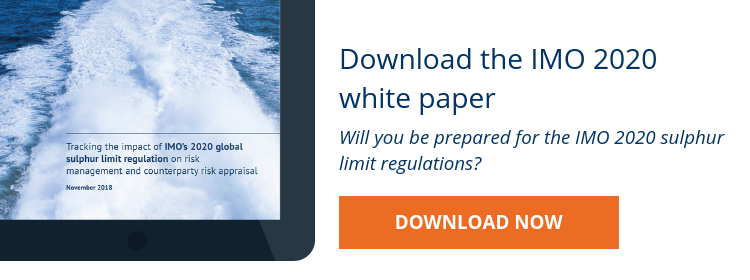
The International Energy Agency called the International Maritime Organization’s (IMO) 2020 global sulphur limit ‘easily the most dramatic change in fuel specifications in any oil product market on such a large scale’. How will the regulation impact the marine industry’s risk management landscape?
The regulation is a daunting prospect for multiple stakeholders, with shipowners and operators, charterers, bunker suppliers, traders, financiers, insurers, and refiners all impacted.
Certain assumptions can be made; HFO prices will likely fall, and LSHFO and distillate prices will likely rise — all while shipowners commit to more capital and potentially take on more debt to fund investment in scrubbers or even LNG capability. Bunker suppliers and traders will face a market featuring larger credit exposures, and likely require access to higher liquidity levels and shorter payment terms to meet higher fuel cost requirements and control escalating credit exposures.
Compliance levels are likely to vary considerably (depending on Flag States and Port State Control jurisdictions), creating a potentially uneven playing field. Insurers are also likely to hike premiums amid high non-compliance and against the higher value of bunker fuel. Regional differentiation to compliance is also likely, with availability of compliant fuels – especially blended 0.5% fuel – expected to dwindle for ships looking to take on fuel away from major bunkering hubs.
While some will benefit from the global sulphur limit, others will suffer — not least in market segments where vessels with scrubbers compete with vessels fuelled by blended 0.5% fuel or distillates. Accurate forecasting will be near impossible going into 2020, meaning that robust risk management will be crucial for businesses planning their next steps.
Which key shipping sectors will be affected?
- Shipowners and operators — Shipowners are responsible for ensuring their ship is compliant and must decide which option to commit to. Looming large over their decision is bunker pricing and availability, both of which are expected to exhibit much less market stability in the last half of 2019 and for most of 2020.
- Charterers — Charterers pay for a vessel’s fuel in around 60% of cases. While the long-term cost implications of 2020 on fuel prices are unclear, in the short-term, charterers with time charters and long-term contracts of affreightment (COAs) could look to move their cargo onto vessels with scrubbers. In doing so, they will likely pay less for HFO than those purchasing distillates or blended/hybrid fuels.
- Bunker suppliers and traders — IMO 2020 is set to trigger a dramatic change in marine fuels globally, from high sulphur fuel (3.5% or lower) to 0.5% low sulphur fuels. This will impact global marine fuel supply composition, market pricing and supply patterns, with buyers needing higher levels of credit and suppliers requiring similar increases in liquidity to continue dealing with the same volume of bunkers.
- Financiers and insurers — Global bunker fuel costs could rise by up to USD 60 billion annually from 2020, while global market share for the scrubber market could surpass USD 8 billion by 2024. This will require financiers to fund investment in technology and extend lines of credit to bunker suppliers, traders and shipowners. Insurance costs and credit insurance premiums are also likely to rise amid the higher value of bunker fuel.
IMO 2020: next steps
Clarity is yet to emerge on who will be ‘winners’ and ‘losers’ of the IMO 2020 regulation. Further away still is conclusive evidence of the success of the global sulphur limit in achieving health and environmental improvements.
However, asset providers will face the largest immediate risks relating to IMO 2020, while from a credit and risk management perspective, available capital will play a key role in how businesses impacted by the global sulphur limit will perform post-2020.
Amid the risks associated with 2020, there are also opportunities. These could include a multi-tiered market influenced by the availability of 0.5% fuels, where charterers may only opt to consider certain types of vessels that deliver affordable, effective and reliable compliance solutions.
For support in assessing your counterparties before making any capital-intensive decisions, please get in touch with your dedicated account manager or nearest Infospectrum office.
To learn about your compliance options ahead of 2020, download our free white paper, ‘Tracking the impact of IMO’s 2020 global sulphur limit regulation on risk management and counterparty risk appraisal’ today.



